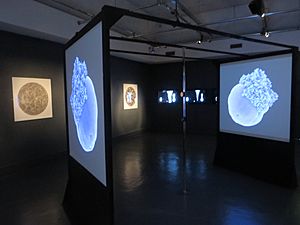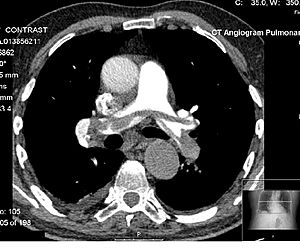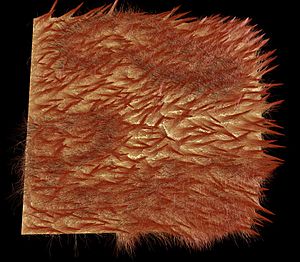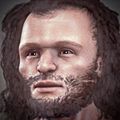Computer-generated imagery facts for kids
Computer-generated imagery (CGI) means using computers to create or help make images. These images are used in art, books, video games, movies, TV shows, commercials, and simulators. The pictures can be still (static) or moving (dynamic). They can be two-dimensional (2D) or three-dimensional (3D). Most often, "CGI" refers to the 3D images used for special effects in films and TV.
CGI animation means moving CGI pictures, like in a movie. A virtual world is a computer-made place you can explore and interact with. Special computer programs help artists and small companies make professional-looking films, games, and art right from their homes. This has led to a whole online community with its own stars and terms. Thanks to CGI, filmmakers can now use "virtual cameras" that aren't limited by real-world physics.
Contents
Static Pictures and Landscapes
CGI isn't just for moving pictures. It can also create natural-looking landscapes, like mountains or valleys. These are made using computer algorithms. A simple way to do this is by using a method called "midpoint displacement." Imagine starting with a big triangle, then breaking it into smaller triangles. The computer then adds small changes to the height of each point. This can create a varied landscape, like a topographical map. Some common computer-made landscapes are called "plasma fractals" and "fault fractals."
Scientists have also found ways to make computer-generated effects look very real. For example, they can model how stones wear down over time. This helps to create an "aged look" for surfaces made of stone.
Building Designs

Today, architects use computer graphics to create 3D models of buildings. These models help both customers and builders see what the finished building will look like. They can be much more accurate than old-fashioned drawings. Architects can also make animated movies of buildings. This helps them see how a new building will fit into its environment and with nearby structures. Using computers to design buildings is now very common.
Architectural modeling tools let architects "walk through" a building or even a whole city virtually. This creates "interactive environments." These tools show not only the building's structure, like walls and windows, but also how sunlight will affect the design at different times of the day.
Many architectural modeling tools are now available online. However, the quality of online systems is still catching up to the more advanced systems used in offices. CGI can even "recreate" old buildings. For example, a computer-made model helped show what a monastery in Germany might have looked like long ago, based on its ruins.
Body Models
Computer models used for animation aren't always exactly like real body parts. But groups like the Scientific Computing and Imaging Institute have made very accurate computer models of the human body. These models are used for teaching and for planning medical procedures. While many medical students still use hand-drawn pictures, more and more online computer models are becoming available.
A single X-ray picture isn't CGI, even if it's digital. But when doctors use CT scans, the computer takes many X-ray slices and builds a 3D model. This is a "computer-generated image." Magnetic resonance imaging (MRI) also uses many "snapshots" to create a detailed internal image of the body.
In modern medicine, doctors create special computer models for each patient. For example, before a total knee replacement surgery, a detailed 3D model of the patient's knee helps plan the operation carefully. These models are usually made from many CT scans of the patient's body. Such models are also useful for planning aortic valve implantations, a common heart procedure. Since heart valves can vary a lot from person to person, a computer model that looks just like the patient's valve helps doctors plan the best way to do the surgery.
Making Cloth and Skin Look Real
Making digital clothes look natural is a big challenge for animators. Computer models of cloth generally focus on three things:
- How threads cross each other.
- How fabric stretches and moves.
- The overall look and shape of the cloth.
Besides movies and ads, top fashion designers now use CGI to create images of clothing.
Making human skin look real in CGI involves three levels:
- Photo realism: Making it look like real skin in a still picture.
- Physical realism: Making it move like real skin.
- Function realism: Making it react to actions like real skin.
Tiny details like wrinkles and pores are very small. Skin can be modeled using complex mathematical functions to capture its appearance.
Interactive Simulations
Interactive visualization means showing data that can change. It lets a user see the data from different angles. This is used in many areas, from showing how liquids flow to computer-aided design. The images can change as the user interacts with the system. For example, flight simulators use a lot of CGI to create a realistic world that changes as the pilot "flies."
In simple terms, interactive visualization takes raw information and turns it into a form that can be shown on a screen. This "visualization data" is then made into a "renderable representation." This representation is then displayed as an image. When the user interacts, like moving a joystick, the system quickly creates a new image. This means the computer needs to work very fast in real-time.
Computer Animation
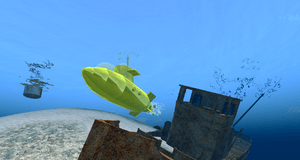
While some computer-generated images are still, computer animation refers to moving images, like a movie. Generally, computer animation means moving images that you can't interact with. The term virtual world is used for animated places where you can interact.
Computer animation is like a digital version of stop motion animation (where you move a model a tiny bit and take a picture) or drawing frame-by-frame. Computer-made animations are easier to control than physical methods, like building tiny models for special effects. CGI also lets artists create images that would be impossible with other technologies. A single artist can make content without needing actors, expensive sets, or props.
To make things look like they are moving, an image is shown on the computer screen. Then, it's quickly replaced by a new image that's slightly different, showing a tiny bit of movement forward in time. This happens very fast, usually 24 or 30 times per second. This is the same way television and movies create the illusion of movement.
Virtual Worlds
A virtual world is a computer-made place where users can interact with animated characters or other users. Users often appear as animated characters called avatars. These avatars are usually shown as text, 2D pictures, or 3D models. Some virtual worlds allow many users to be in the same place at once.
In Courtrooms
CGI has been used in courtrooms since the early 2000s. It helps judges and juries understand what happened in a case. For example, it can show how an accident might have unfolded. However, some experts worry that these images can be too convincing. A study in 1997 showed that people can be easily influenced by computer-generated images. So, it's important for everyone in court to remember that these images are just one possible way things might have happened.
-
A computer-made picture of Saint Paul, based on old records.
-
What a Cro-magnon person might have looked like, based on ancient skulls.
See also
 In Spanish: Imagen generada por computadora para niños
In Spanish: Imagen generada por computadora para niños


